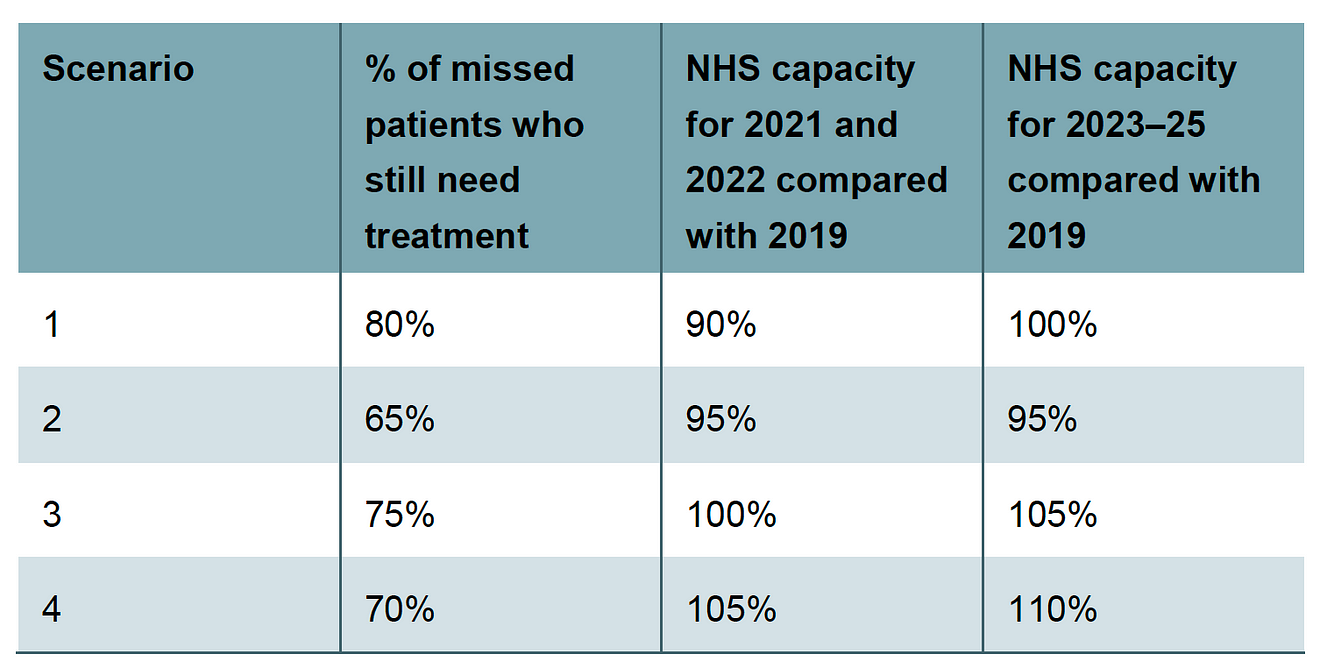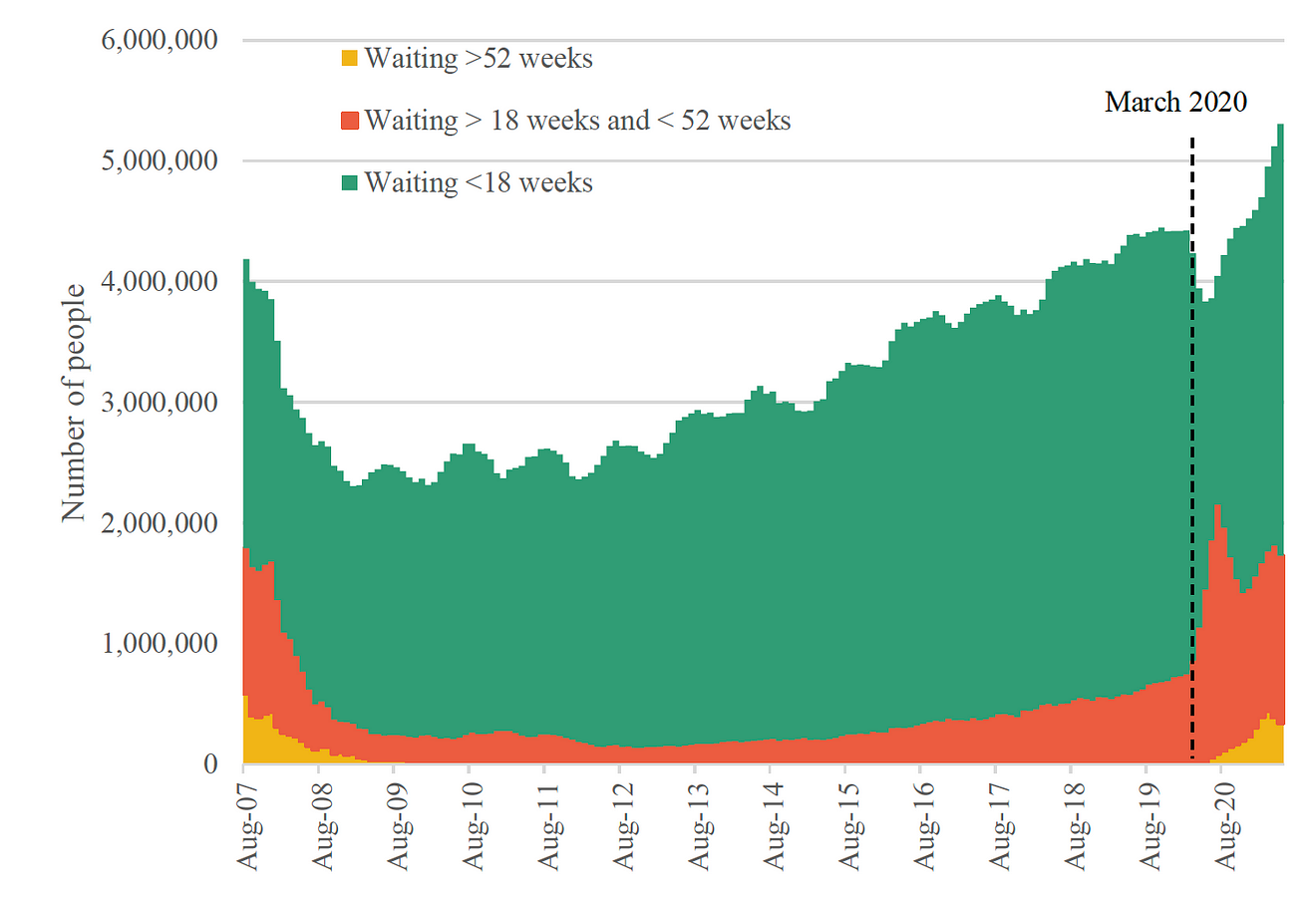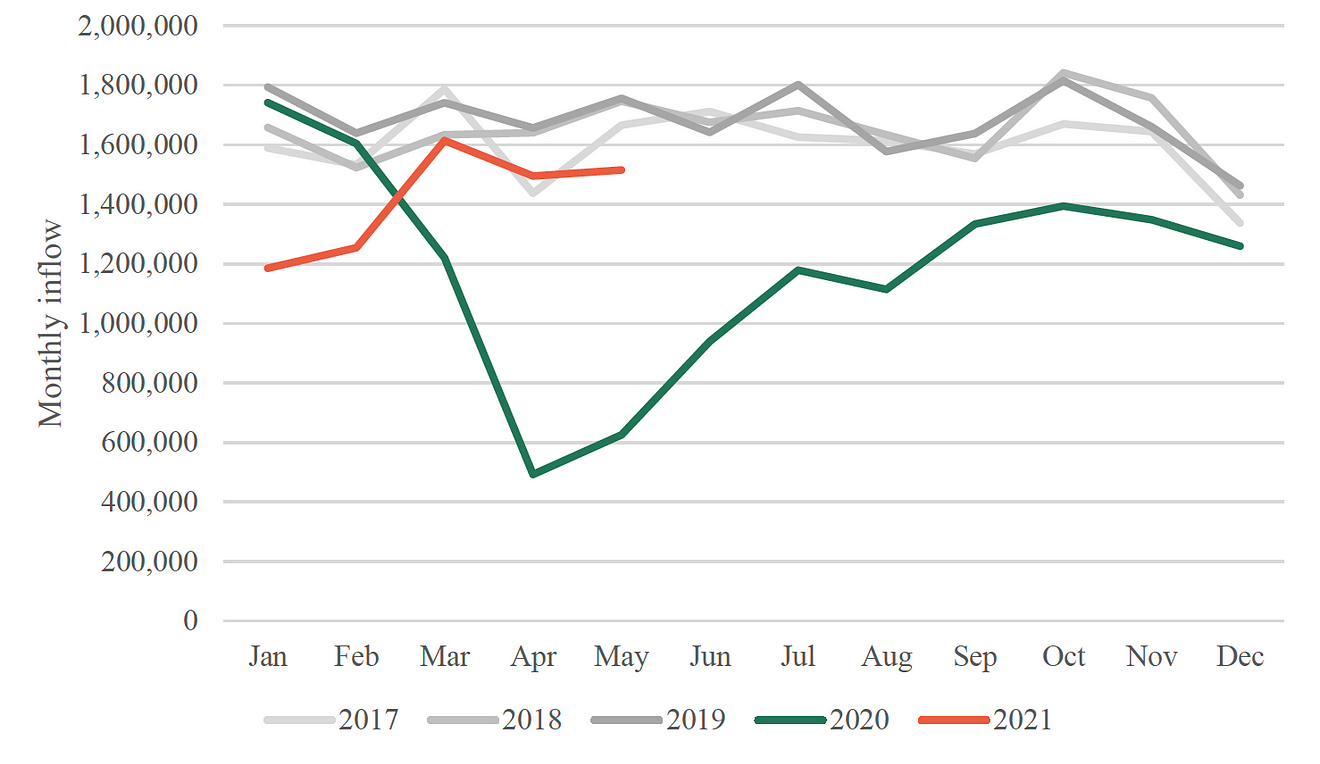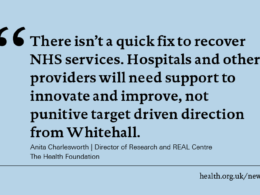Joaquim Cardoso, MSc
August, 10th, 2021
This is an excerpt from the article “Could NHS waiting lists really reach 13 million?”, published by the organization and authors below:
IFS — Institute for Fiscal Studies
George Stoye, Max Warner and Ben Zaranko
08 Aug 2021
credit to the image on top: lynchburg
Key Messages (Edited by the author of this Blog)
Introduction
- Since the start of the pandemic, the number of people waiting for NHS treatment in England has grown by a fifth (20%).
- Yet the number of people on the waiting list is expected to rise much further.
- But, taking a step back, the growth in waiting lists until now has actually been remarkably small given the incredible disruption to the NHS from COVID-19. This is because at the same time as hospital activity fell — and so fewer people ‘exited’ from the waiting list — so too did the number of people joining the waiting list following a referral from a GP or hospital consultant.
What the NHS waiting lists looks like in the future?
In answering that question, there are two major factors to consider.
- The first is what happens to the patients who did not receive care during the pandemic.
- The second factor is what happens to NHS capacity for non-COVID treatment
With these considerations in mind, Figure 3 presents illustrative scenarios for waiting lists over the next four years.
- In our first scenario, 80% of the approximately 7 million ‘missing’ patients return over the next year, the NHS operates at 90% of its 2019 capacity this year and next, and then at 100% capacity from 2023 onwards.
- Even in our most optimistic scenario (scenario 4), the number of people waiting for treatment would rise to over 9 million next year, and would only return to pre-pandemic levels in 2025.
- That would see waiting lists rise before falling gradually, but by the end of 2025 the waiting list would still be around 8.6 million — almost double its pre-pandemic level.
- The table below gives a summary of the 4 scenarios.

Implications
- That would require the NHS to increase capacity by 5% in 2021 and 2022 compared with 2019 and then by 10% in 2023 onward (the equivalent of treating around 1.6 million additional patients per year, relative to 2019 volumes, at a potential annual cost of at least £2 billion, before any allowance for additional infrastructure).
NHS capacity will be the ultimate determinant of what happens to waiting lists
- Our scenarios show that, in the longer run, whether or not waiting lists remain high will ultimately be determined by what capacity the NHS can achieve in the coming years.
- The future path of the pandemic will be of huge importance.
- But lower case numbers could have the opposite effect on waiting lists in the shorter run, if it meant patients felt safer interacting with the medical system and were less concerned about burdening the NHS during the pandemic, making them more likely to come forward with non-COVID health problems (and, in turn, more likely to be referred on for hospital treatment).
Importantly, while this would increase the size of the waiting list as a greater number of patients return for treatment, it would ultimately improve the health of these people — a reminder that the size of the waiting list is not ultimately the only thing that matters.
Given these pressures, there will also undoubtedly be calls for additional funding and resources, on top of those already committed, to help the NHS deal with the backlog.
Given these pressures, there will also undoubtedly be calls for additional funding and resources, on top of those already committed, to help the NHS deal with the backlog.
FULL VERSION OF THE ORIGINAL PAPER

Could NHS waiting lists really reach 13 million?
IFS — Institute for Fiscal Studies
George Stoye, Max Warner and Ben Zaranko
08 Aug 2021
credit to the image on top: hodge, jones & allen
Introduction
Since the start of the pandemic, the number of people waiting for NHS treatment in England has grown by a fifth (20%).
5.3 million people were waiting for treatment in May 2021, up from 4.4 million in February 2020. There has been a particularly sharp increase in the number of people waiting for longer than a year, causing widespread concern over the scale of the NHS ‘backlog’.
Yet the number of people on the waiting list is expected to rise much further.
Sajid Javid, the new Health and Social Care Secretary, has warned that it is ‘going to get a lot worse before it gets better’ and could grow to 13 million.
In this observation — published as an early output of the 2021 IFS Green Budget, in association with Citi and funded by the Nuffield Foundation — we set out how the numbers in England on the NHS waiting list changed before and during the pandemic and discuss the key factors that will affect how much they will grow in the near future.
We then present illustrative scenarios of potential waiting lists over the next four years to assess the plausibility of Mr Javid’s 13 million figure and to understand the conditions under which it might arise.
Waiting lists during the pandemic
Figure 1 shows the number of people on a waiting list for pre-planned NHS care in England.
The number of people on the waiting list has increased by around 900,000 since the start of the pandemic and now stands at 5.3 million — the highest level since the current definition was introduced in 2007, and more than twice the January 2009 figure of 2.3 million, when the waiting list was at its shortest. (Note that here and throughout we follow convention in referring to the ‘number of people’ on the waiting list, but it is possible for an individual to appear on the list more than once if they have more than one incomplete treatment pathway.)
The biggest change over the past 15 months has been in the number of people waiting longer than a year for their care. On the eve of the pandemic in February 2020, only around 1,600 people had been on the list for a year or longer. By May 2021, this had increased to almost 340,000 — down from the March 2021 figure of 436,000, but still a 200-fold increase on pre-pandemic levels.
Figure 1. NHS England waiting list

But, taking a step back, the growth in waiting lists until now has actually been remarkably small given the incredible disruption to the NHS from COVID-19. Indeed, the list increased by the same amount between March 2016 and February 2020.
Previous work by IFS researchers showed that in the first 10 months of the pandemic, there were 3 million fewer elective admissions and 17 million fewer outpatient appointments than in the same period the previous year. And yet there are less than a million more people on the waiting list than before the crisis.
This is because at the same time as hospital activity fell — and so fewer people ‘exited’ from the waiting list — so too did the number of people joining the waiting list following a referral from a GP or hospital consultant.
This is demonstrated by Figure 2. In fact, over the first few months of the pandemic, the number of people joining fell even faster than did hospital activity, so that the waiting list actually fell between March and May 2020.
The reduction in the number of joiners is likely due to a mix of changes in the behaviour of patients (who were less likely to seek care as a result of concerns over potential infection and a desire not to overburden the NHS), genuine reductions in the need for care (e.g. due to fewer industrial and sporting injuries requiring elective or outpatient care) and changes to how the NHS and doctors operated.
Between March 2020 and May 2021, there were 7.4 million fewer people joining the list than implied by pre-pandemic patterns.
Figure 2. Number of people joining the waiting list, by month

What the NHS waiting lists looks like in the future?
Given all of that, what might happen to NHS waiting lists in the months and years ahead — and could waiting lists really reach 13 million?
In answering that question, there are two major factors to consider.
- The first is what happens to the patients who did not receive care during the pandemic.
As noted above, since March 2020, 7.4 million fewer people have joined the waiting list than implied by pre-pandemic patterns. This is lower than the number of missed admissions and appointments because each waiting list pathway may involve multiple treatments. However, it is unknown how many of these patients will eventually join the waiting list, and over what period. It is also unknown whether the health status of these patients will have deteriorated as a result of the delay in their treatment, with sicker patients potentially requiring more resources to treat.
It is unlikely that all patients will return: some will have died since the start of the pandemic, others may have received treatment privately, while some will have had their ailments resolved (or have chosen to live with these health issues) without ultimately requiring hospital treatment. But some — perhaps most — of these ‘missing’ people will still require NHS treatment at some point, particularly when COVID-19 case numbers drop and people are more willing to seek healthcare. The extent to which these ‘missing’ patients come forward for care, and how quickly, therefore represents a hugely important ‘known unknown’ for the health service.
- The second factor is what happens to NHS capacity for non-COVID treatment. (We define capacity here as the amount of elective activity that the NHS can deliver in a given period.)
The NHS is currently trying to return to pre-pandemic capacity, with hospitals incentivised to return to above 95% of their 2019 volumes. But the need to still devote many resources towards treating acutely ill COVID-19 patients, infection control measures, staff sickness and self-isolation, and many other factors, all limit hospitals’ ability to reach pre-pandemic activity levels. In May 2021, admissions from the waiting list were just 82% of their 2019 level. Despite this being much higher than earlier in the pandemic, it will not be enough to deal with the growing demand for treatment. Indeed, demand often exceeded supply in the years prior to the pandemic, and waiting lists were already growing over time.
With these considerations in mind, Figure 3 presents illustrative scenarios for waiting lists over the next four years.
We show four scenarios to illustrate the sensitivity to various assumptions over the number of ‘missing’ patients who return and future NHS capacity. The relevant assumptions for each scenario are listed in Table 1. It should be emphasised that there is a great deal of uncertainty around each assumption, and so Figure 3 should be interpreted as scenarios of what could happen, rather than predictions of what will happen. Waiting list projections under different assumptions can be generated using the interactive tool on our website.
- In our first scenario, 80% of the approximately 7 million ‘missing’ patients return over the next year, the NHS operates at 90% of its 2019 capacity this year and next, and then at 100% capacity from 2023 onwards.
Under this scenario, waiting lists would soar to 14 million by the autumn of 2022 and then continue to climb, as the number joining the waiting list exceeds the number being treated.
- In our second scenario, a smaller proportion (65%) of ‘missing’ patients return, and the NHS operates at 95% capacity for the full period.
In that case, waiting lists would still rise to an enormous 11 million within a year and then continue to climb on a worrying upwards trajectory to over 15 million by the end of 2025, as supply fails to keep pace with demand. This suggests that Mr Javid’s warning of a 13 million waiting list is by no means beyond the realms of possibility if the NHS struggles to return to full capacity. Failure to return to at least pre-pandemic capacity could see waiting lists on an ever-rising trajectory as demand continues to outpace supply.
- In scenario 3, we show what would happen if 75% of patients returned, the NHS operated at 100% capacity (i.e. at 2019 levels of activity) this year and next, and managed to add an additional 5% of capacity from 2023 (the equivalent of treating an additional 800,000 patients per year, which could come at an annual cost of at least £1 billion, even before accounting for the need for any additional infrastructure).
That would see waiting lists rise before falling gradually, but by the end of 2025 the waiting list would still be around 8.6 million — almost double its pre-pandemic level.
- Even in our most optimistic scenario (scenario 4), the number of people waiting for treatment would rise to over 9 million next year, and would only return to pre-pandemic levels in 2025.
That would require the NHS to increase capacity by 5% in 2021 and 2022 compared with 2019 and then by 10% in 2023 onward (the equivalent of treating around 1.6 million additional patients per year, relative to 2019 volumes, at a potential annual cost of at least £2 billion, before any allowance for additional infrastructure).
Figure 3. Illustrative waiting list scenarios

Table 1. Waiting list scenarios assumptions

NHS capacity will be the ultimate determinant of what happens to waiting lists
- Our scenarios show that, in the longer run, whether or not waiting lists remain high will ultimately be determined by what capacity the NHS can achieve in the coming years.
The number of COVID-19 patients requiring treatment and the extent to which the NHS can adapt to (or relax) infection control measures will be crucial determinants of this capacity. The number of ‘missing’ patients returning for treatment will affect by how much waiting lists rise initially, but is less important for the medium-term trajectory.
- The future path of the pandemic will be of huge importance.
This path is, of course, highly uncertain. But a lower rate of societal infection and the continued success of the vaccination programme would mean fewer patients requiring treatment for COVID-19 in hospital and might eventually allow for a relaxation or adjustment of infection control measures. Perhaps the best thing that the government could do for waiting lists, then, is to ensure the virus is kept under control.
- But lower case numbers could have the opposite effect on waiting lists in the shorter run, if it meant patients felt safer interacting with the medical system and were less concerned about burdening the NHS during the pandemic, making them more likely to come forward with non-COVID health problems (and, in turn, more likely to be referred on for hospital treatment).
Importantly, while this would increase the size of the waiting list as a greater number of patients return for treatment, it would ultimately improve the health of these people — a reminder that the size of the waiting list is not ultimately the only thing that matters.
Given these pressures, there will also undoubtedly be calls for additional funding and resources, on top of those already committed, to help the NHS deal with the backlog.
Future IFS research, to be published in the final Green Budget volume later this year, will examine this and related issues in more detail. What is already clear, though, is that clearing the backlog will be a major challenge for the NHS. Sir Simon Stevens, the outgoing NHS England Chief Executive, has suggested that, with the right resources, the backlog could be cleared over the next two-and-a-half to three years.
Our analysis shows that achieving this would require the NHS to find effective ways to boost its capacity. If that cannot be done, clearing the backlog will take even longer.
This analysis was funded by the Nuffield Foundation as an early output of the 2021 IFS Green Budget.
The Nuffield Foundation is an independent charitable trust with a mission to advance educational opportunity and social well-being. It funds research that informs social policy, primarily in Education, Welfare and Justice.
It also provides opportunities for young people to develop skills and confidence in science and research.
The Foundation is the founder and co-funder of the Nuffield Council on Bioethics, the Nuffield Family Justice Observatory and the Ada Lovelace Institute.
Originally published at https://ifs.org.uk on August 8, 2021.












